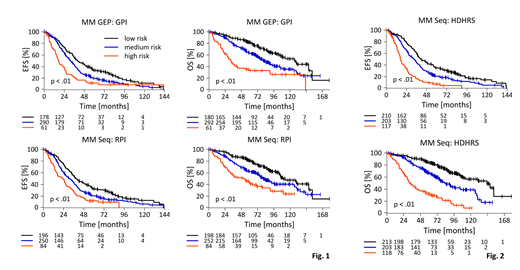Aim of our study is to implement RNA-sequencing as basis for risk adapted and targeted treatment-strategies in multiple myeloma. We establish assessment of malignant plasma cell proliferation and risk-stratification de novo (HDHRS) by RNA-sequencing, transfer microarray-based risk scores to RNA-sequencing, and report expression of actionable including immune-oncological targets.
Methods. Transcriptome profiling was performed on CD138 purified malignant plasma cell samples from previously untreated symptomatic multiple myeloma patients undergoing high-dose melphalan treatment and autologous stem cell transplantation. RNA-sequencing was performed on an Illumina NextSeq500-platform using 5ng of total RNA (n=535), and, in the same cohort, by gene expression profiling using Affymetrix U133 2.0 DNA-microarrays (n=534). iFISH was performed using a ten-probe panel (n=535). Clinical data and survival of patients treated with high-dose therapy and autologous stem cell transplantation were assessed (n=534/533/534 for RNA-seq/GEP/iFISH) with median follow up of 64 months. Data were validated using the independent COMPASS cohort (n=767 pts., median follow up of 31 months).
Results. RNA-sequencing is feasible in more than 90% of myeloma patients. It allows assessment of proliferation (RPI) and risk, both de novo (HDHRS) and regarding microarray-based scores (UAMS GEP70-, EMC92-, Rs-score). All scores are significantly predictive for overall and event-free survival in GEP are likewise in RNA-seq with hazard ratio for high risk to low risk group of 3.06, 4.3, 2.84, 3.93 and 3.30 in overall survival of test group. (See as example gene expression based proliferation index / RNA-seq based proliferation index, Fig. 1). The de novo RNA-seq risk stratification (HDHRS) superiorly delineates three significantly different groups of 40%, 38%, and 22% of patients with 5-year survival rates of 84%, 67%, and 32%, respectively (Fig.2). It likewise discerns a group of long term surviving patients with a survival rate of 57% and 49%, at 10 and 12 years, respectively. Targets expressed in normal plasma cells with varying expression height in malignant include BCMA and CD38, those aberrantly expressed CSF1, CD20 and HGF. Mutated actionable transcripts include BRAF V600E/K (target), the proteasome and cereblon (resistance).
In conclusion, RNA-seq allows assessment of risk, long term survival and targets in multiple myeloma both in phase III multicenter trials as well as in clinical Routine.
Moreaux:Diag2Tec: Other: Co-founder of Diag2Tec company.
Author notes
Asterisk with author names denotes non-ASH members.


This feature is available to Subscribers Only
Sign In or Create an Account Close Modal